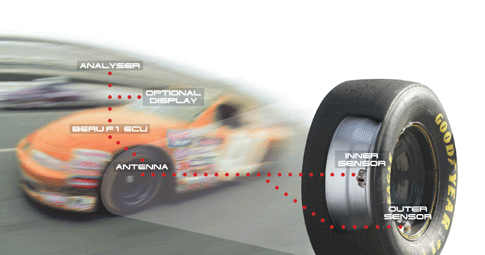

Checking your tire pressure might save you a few cents on gas, but the technology behind rubber meeting road is a bit more critical in F1 racing than in commuter frugality. Professional teams have long collected data on tire pressure and air temperature through sensors on a tire’s valve stem during a race. But these sensors are susceptible to “heat soak” from the rim, and brakes and were unable to measure the critical temperature of the actual tire carcass. While air temp is good for puncture detection, the carcass data is necessary to adjust pressures for optimal rubber wear and fuel efficiency. Thanks to a new sensor from BERU, this data is now readily available. Two “top tier” teams, whose names remain confidential, have already purchased the system for use in the 2009 season.
The BERU Infrared sensor connects to a tire’s rim, providing more accurate data than valve-stem sensors do. The infrared functionality ‘fires a beam’ at the tire carcass to determine the temperature; this information is transmitted to the race crew in the pit area in real time. The system claims an impressive resolution of just 0.25 degrees C and transmits data once per second. Based on the readings, a crew can adjust tire pressure, and a car’s suspension system, to optimize wear on the tires. At less than two inches long and weighing less than 40 grams, the sensor has no adverse effect on the car performance.
While F1 teams are expected to line up by the droves to incorporate this new technology into their teams’ processes, their counterparts at NASCAR might have to wait a while. NASCAR tires have inner and outer carcasses, making the detection of the outer carcass temperature a more difficult proposition (according to BERU engineers). Perhaps more restrictive, NASCAR currently does not allow real-time tracking of tire data, so the technology could only be used in testing and practice laps. So, what about improving the gas mileage on your minivan? BERU is looking into developing cheap methods that will apply their technology to commuter vehicles. More importantly, the trucking industry could benefit greatly from optimal tire configurations. According to BERU, cost is a function of volume, and they would not offer estimates for their current technology.

